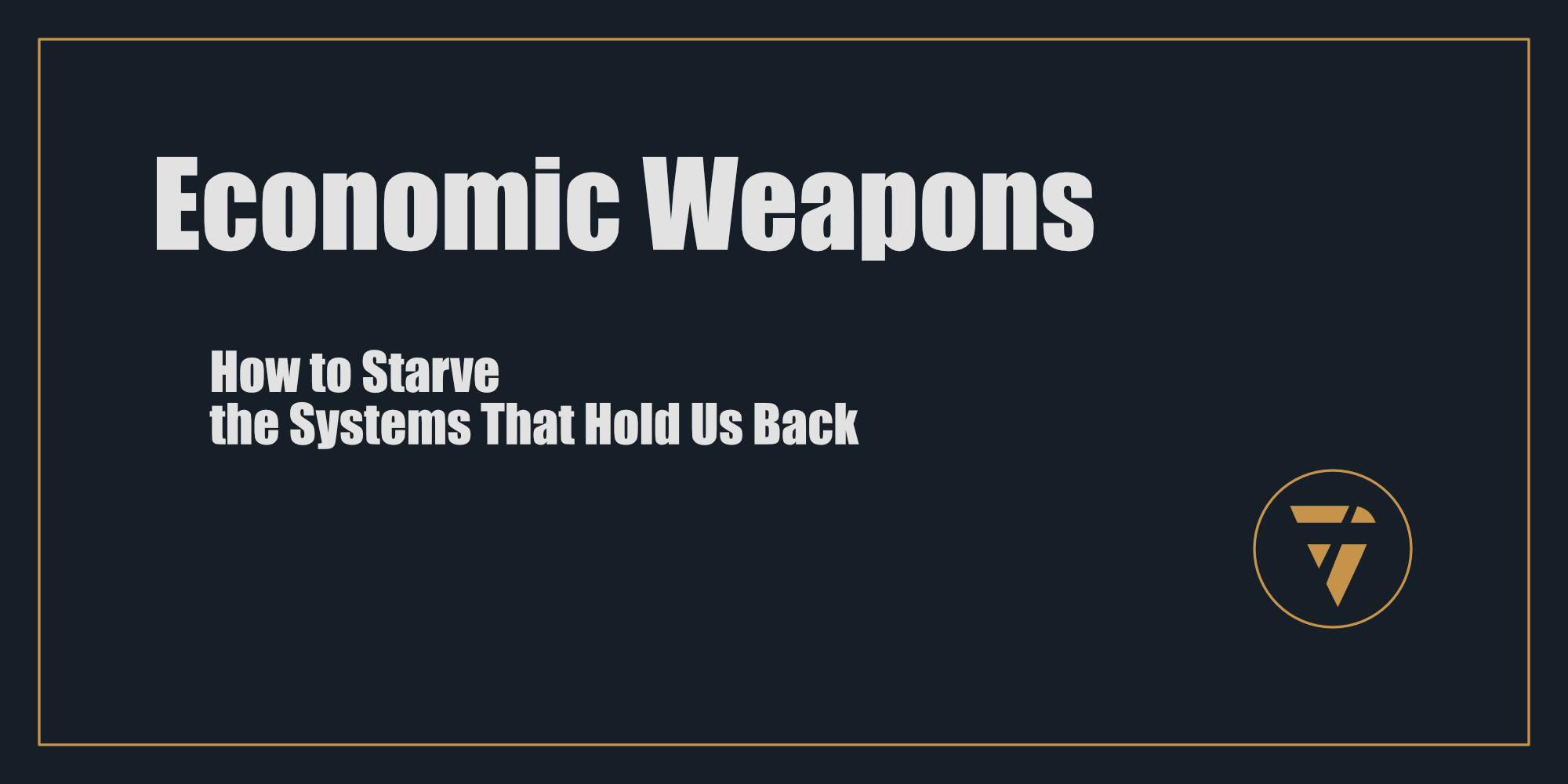Economic Weapons
How to Starve the Systems That Hold Us Back

Power Doesn’t Crumble—It’s Choked.
Here’s a wake-up call: the fight for change isn’t failing because we’re not trying. It’s failing because we’ve been aiming at the wrong target.
You can chant, vote, and tweet until you’re blue in the face. But as long as the systems of power keep their revenue streams intact, nothing changes. They’re not broken; they’re thriving. Why? Because they don’t care about your outrage. They care about money.
Want to disrupt them? Starve them.
This isn’t about destruction; it’s about innovation. The only way to dismantle the systems that exploit us is to hit their bottom line and replace them with something better.
The Tools to Disrupt Revenue Flows
To win this fight, you need a sharp toolkit—strategies and systems to cut off their cash and build ethical alternatives. Here’s how:
Tool 1: Transparency—Expose Their Weaknesses
What It Does:
Transparency kills the shadow games monopolies thrive on. Expose their revenue streams, their exploitative practices, and their inefficiencies.
How to Implement It:
- Follow the Money: Use public records, investigative reports, and tools to map their revenue sources.
- Crowdsourced Intelligence: Encourage whistleblowers and grassroots activists to share what they know.
- Publish and Share: Platforms like Substack or Medium allow you to document and share findings widely.
Example: Investigative reporting on exploitative labour practices in fast fashion shifted billions in consumer spending to ethical brands.
Tool 2: Economic Pressure—Redirect Spending
What It Does:
Boycotts and divestment campaigns starve harmful systems by cutting off their revenue streams.
How to Implement It:
- Identify Key Revenue Sources: Focus on high-margin products or services that drive profitability.
- Mobilize Consumers: Use social media platforms and grassroots campaigns to amplify your message.
- Provide Alternatives: Pair your boycott with a call to action: where people should spend their money instead.
Example: The anti-apartheid divestment campaign forced financial institutions to cut ties with South Africa, crippling its economy and dismantling systemic racism.
Tool 3: Build Ethical Alternatives—Outcompete the System
What It Does:
You don’t win by shouting at the incumbents. You win by building something better that consumers can’t ignore.
How to Implement It:
- Identify Market Inefficiencies: Find where monopolies are failing—be it cost, quality, or ethics.
- Solve the Problem: Build a product or service that’s faster, cheaper, and better aligned with public values.
- Scale Without Selling Out: Leverage crowdfunding, cooperatives, or impact investors to maintain ethical control.
Example: Fair-trade coffee didn’t just disrupt exploitative supply chains; it proved consumers will pay more for transparency and ethics.
Tool 4: Narrative Power—Control the Conversation
What It Does:
Public sentiment shapes consumer and investor behaviour. Own the narrative to amplify your impact.
How to Implement It:
- Create Compelling Stories: People care about stories, not spreadsheets. Highlight the human impact of harmful systems.
- Use Digital Platforms Wisely: TikTok, Instagram, and YouTube are tools for storytelling, not just noise.
- Build a Movement: Align your message with shared values like sustainability, fairness, and community.
Example: Branding around sustainability doesn’t just sell jackets—it shapes how we view corporate responsibility.
Case Study: Renewable Energy vs. Fossil Fuels
- Transparency: Fossil fuel companies lobby efforts to block renewables. Stop the spend.
- Economic Pressure: Divestment campaigns pulled billions from oil stocks.
- Ethical Alternatives: Solar and wind companies offered cheaper, cleaner energy.
- Narrative Power: Activists reframed renewables as a moral and economic imperative.
The result? Fossil fuel companies are scrambling to stay relevant in a world that’s leaving them behind.
Keep pushing.
Putting It All Together
Want to start disrupting? Here’s a simple plan:
- Pick a Target: Choose an industry, company, or harmful practice you want to dismantle.
- Do Your Homework: Map their revenue streams, expose their weaknesses, and identify where they’re vulnerable.
- Use the Tools: Apply transparency, economic pressure, ethical competition, and narrative power to starve their system.
- Measure and Adapt: Track the impact of your efforts and refine your strategy as you go.
Want direct, targeted tactics to divert revenue? ben@proconsul.ca
This Is the Fight That Matters
Power doesn’t crumble under moral outrage. It shifts when the money stops flowing. If you want real change, you need to go beyond hashtags and headlines. You need to attack the systems where it hurts—at their bottom line—and replace them with something better.
The tools are here. The opportunity is now. The only question is: What will you build?
Let’s stop asking for change and start creating it.
Ready?
- Subscribe for more tools, frameworks, and case studies.
- Email me your questions, targets, or ideas—I’m here to help: ben@proconsul.ca.
- Start building.
It’s not about shouting louder. It’s about starving the systems that silence us. Let’s get to work.
This Substack is reader-supported. To receive new posts and support my work, consider becoming a free or paid subscriber.
This is what I’m working on. Tell me what you think, I enjoy the conversation! Subscribe and follow the work in real time.
Thanks!
B
Money talks. And it’s not speaking for you.
The systems we fight today will fall, not because we destroy them, but because we build something they can’t match. Innovation is resistance.
PS -





